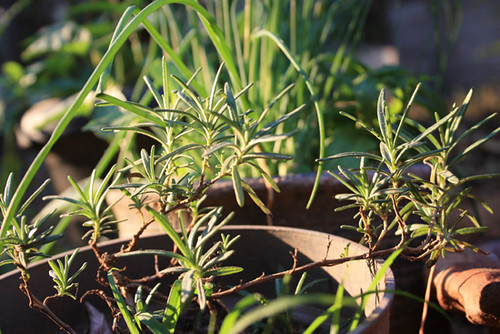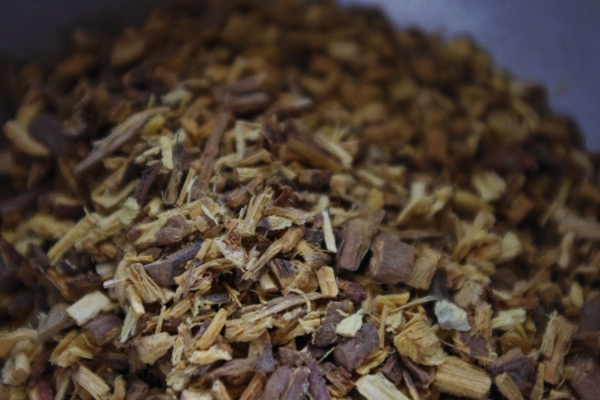Medicinal Uses of Common Culinary Herbs
You may have thought that I forgot about going on and on about Wives and Mothers as Keepers of the Health. Well I had to for a while with everything else that has come up recently. Now the time is right, so let’s kick this series off with something that most of us already have in our kitchen cabinets – cooking herbs.
The past few years I have really fallen in love with herbs – both for cooking and medicinal uses. When I picked up a book titled "Herb Grower’s Guide" a while back I was pleased to see that many of the herbs that we know as culinary today were once used medicinally as well.
I thought that I would list some of the ones that I use – fresh or dried – and then you can share some of your own.
Basil
Most of us are familiar with sweet basil, but there are many varieties. All basils contain anti-inflammatory properties and antioxidants. Tulsi, or holy basil, is particularly effective as an immune boosting tea. Many residents of India keep tulsi plants in their homes and gardens and drink the tea or eat the leaves in various dishes daily. It is reported to fight or ward off infections and influenza.
How to Use: Obviously sweet basil is delicious with tomatoes of all sort. It is also great in Thai dishes, especially if you can grow or get Thai basil. Holy basil will make a great immune boosting tea along with other immune boosting herbs such as astragalus and the vitamin C-rich rosehips.
Cilantro
Cilantro is one of those flavors that people either love or hate. I personally love it, especially in fresh salsas. Cilantro has been shown to have antibacterial properties and to aid in the chelating of heavy metals (source).
How to Use: Fresh cilantro is delicious in Mexican and Asian dishes. Salsas, salads, and soups can all benefit from this delicious herb. Cilantro makes a deliciously different pesto as well.
Oregano
The "pizza herb" is well known as an anti-viral and anti-fungal. I recently purchased a bottle of oregano oil to aid in the regular boosting of our immune systems. It can also be used to treat fungal infections, internally or externally. Oregano has also been found to soothe bee stings or snake bites.
How to Use: Use oregano liberally with tomatoes, vegetables, or eggs. Use a bottle of oregano oil to combat candida or fight viral challenges.
Parsley
We have all seen the curly variety of parsley used as garnish, but at one time that garnish served a purpose. Parsley is known to ward of bad breath when chewed after a meal. It also contains apiol and myristicin, which give parsley it’s diuretic, and therefore cleansing, properties.
How to Use: I love Italian flat-leafed parsley in salads, soups, sauces, and just about anything needing a touch of freshness.
Rosemary
This woody herb has a long history of relieving many ailments including stomach upsets, digestive disorders and headaches. It is also thought to aid memory and other brain functions. Not only that, but it’s essential oils have long been used for skin and hair care.
How to Use: I use rosemary mostly in the dried form in soups, stews, casseroles, and sauces. It could also be steeped as a tea or perhaps a hair rinse.
Thyme
What would chicken soup be without this delicious herb. But I have personally seen the medicinal benefits of this herb. Thyme makes an effective tea for coughs, congestion, and colds. I served my husband and 3 year old cups of lemon thyme tea when they both were fighting off congestion and colds. Without fail their coughs would greatly diminish throughout the day when they had a warming cup at breakfast.
How to Use: Steep thyme in hot water as a tea, or use it liberally in soups, with poultry, and roasted vegetables.
Sage
This herb that we all know as the perfect accompaniment to turkey was used for anything and everything in times past. It was best known to prevent colds, aid rheumatism, and is especially effective against indigestion. Sage tea is still widely drank in China and other cultures, especially after meals.
How to Use: Throw some sage in with your poultry or beef roasts to aid in the digestion of the fats. Add it to soups or stews or simply brew a nice cup of sage tea.
Purchasing and Storing Herbs
Obviously the best thing to do is grow your own, use them fresh, and then dry them for winter use. I was able to dry quite a bit of sage and thyme from my herb garden this year because they were the most prolific. For every thing else I like to buy in bulk from a store I know uses organic practices and has a good turn over, such as Mountain Rose Herbs. Most herbs and spices lose their flavor and medicinal properties with time so it is important to know that you are getting a fresh product.
You should also be careful as some herbs have contraindications. I have read, for instance, that pregnant and nursing women should not regularly consume parsley or sage teas due to their effects on the uterus and milk supply.
There are many more herbs, not to mention spices, that I haven’t covered and perhaps will some day. In general herbs, especially fresh, are a wonderful addition to foods of all kinds. All leafy greens, like herbs, contain antioxidants and a variety of vitamins and minerals that are beneficial to us all. I am excited to expand my herb garden next year and discover more wonders of these delicious medicinals.
How about you... do you have any medicinal uses for common culinary herbs?
Sources (unless otherwise noted):
- Herb Grower’s Guide by John Prenis
- Herbal Properties & Benefits
- Random information I have picked up from books and websites.
This information is for educational purposes only and is not intended to treat, cure, or prevent any disease or condition. Please don’t just take my word for it, I am not a medical professional. In the spirit of full disclosure: I am an affiliate of Mountain Rose Herbs and as such will earn a small commission if a product is purchased through the above link. That being said, I would share all of this information and recommend their products regardless, because I find it helpful and personally useful.




Shannon, for my holistic wellness course I am required to do a few book reports. I just started reading Growing 101 Herb That Heal by Tammi Hartung. This post is perfect timing.
also, I appreciate your list of non-local foods on my blog this morning. Especially glad that coffee was on it : )
Medicinal use of herbs is something that I’ve just become interested in, and am starting to research. Thanks for the great information!
I LOVE herbs for cooking and use them often and liberally. Hopefully we’re already reaping some of their benefits. I grow basil, oregano, thyme, tarragon and rosemary. Though I just lost my rosemary plant, and will have to start new. I plan to expand next year as well.
Thank you, Shannon, for a very informative post. I look forward to growing more herbs here on our homestead in the future. I know we have some medicinal herbs and plants growing on our land. I just need to take time to walk around and educate myself to be able to identify them and harvest them properly.
Thanks again!
Susan
Thank you for your list of medicinal herbs for keeping families healthy. With everything so processed and full of additives from the local grocery store, it is important to remember that growing your own herbs or buying them from specialty stores is a fantastic and much more wholesome way to feed your family.